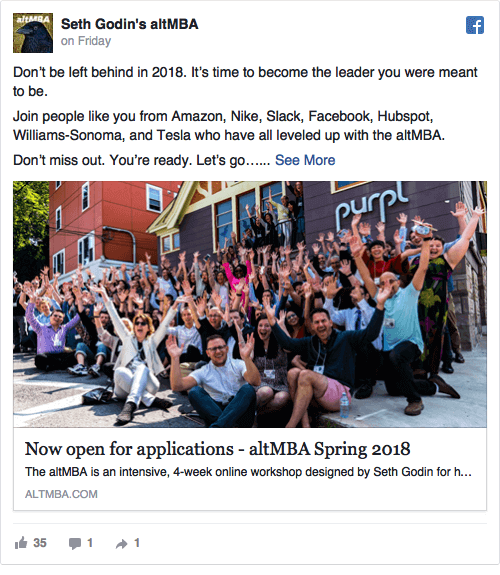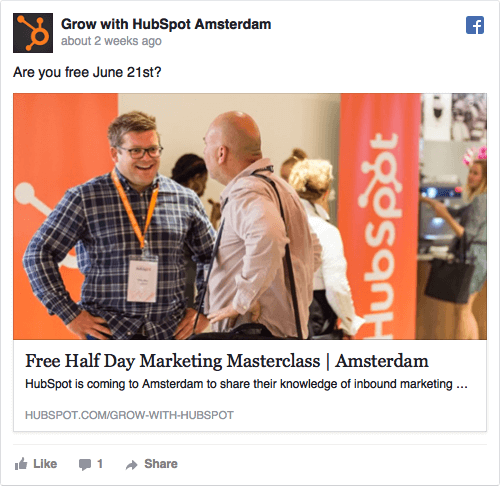People of every age from all around the world log into Facebook daily to check in with their families and friends, get news updates, and even meet new people. As an all-in-one dashboard for stories and information, Facebook does an excellent job of connecting us.
Unfortunately, many businesses fail to remember what Facebook is really all about. Instead, they see Facebook timelines as an opportunity to sell to more leads and make more money. They forget about the “social” part of social media.
Advertising on Facebook can be a great opportunity for businesses in just about every industry – but only when done correctly. If ads are dull, boring, or uninteresting, Facebook users are likely to just scroll on by.
So if you want your Facebook ads to get noticed, it’s time you start approaching them a bit differently.
The Anatomy of a Typical Facebook Ad
Typical Facebook ads are easy to spot. If the “sponsored” badge isn’t enough of a sign, ads typically have more text and a call-to-action button. However, one of the most glaring signs that a post is sponsored is the stock image.
Stock images find their way into many different areas of marketing. While stock images may have their place, it’s typically not on Facebook or other social media platforms.
It’s usually easy to identify a stock image. They’re slick, look posed, and are, frankly, a bit too perfect. These overly photoshopped images stick out on Facebook timelines, so users typically breeze right past them – without taking a second look at what your ad is really offering.
Trying to decide if Automation Agency is the right fit for you? Take this quick quiz to find out.
The Appeal of Natural Images in Advertising
Facebook users typically aren’t expecting to engage with businesses and brands when they get online. Instead, they want to see content uploaded by their friends and family. So, in order to get your ads noticed, you actually need to blend in.
By using natural images rather than stock images, you can make your Facebook ad look more like it was uploaded by someone your target audience follows. While natural images are not as “perfect” as stock images, they are more authentic, giving your audience a chance to get to know the real you.

Seth Godin’s ad to promote his online workshop, altMBA, uses a fun group photo.
For example, taking your own pictures give fans, followers, and potential clients a true look into your day-to-day business. Instead of a stock image they’ve probably seen plastered across the web, natural images allow you to establish trust and encourage audience members to engage more.
Imagine you’re a business coach wanting to promote your services on Facebook. Which do you think will get the most engagements: a stock image of perfectly placed models sitting around a conference room table, or an action shot from your last live training or speaking event?
 Darren Hardy uses a real image from a previous speaking event to promote his video training series.
Darren Hardy uses a real image from a previous speaking event to promote his video training series.
The image of you in your natural habitat, performing the actions you’re looking to advertise, allows potential clients or customers to imagine themselves in the experience. Rather than making people wonder what you look like, what the event is like, or what you’re really offering, natural images provide honest depictions of what the customer gets if they choose to purchase.

HubSpot Amsterdam uses a natural image to promote their Marketing Masterclass.
Facebook, like many other social platforms, is always looking to improve its user experience. (Case in point: their latest algorithm.) If you are getting more engagements on your natural-looking sponsored posts, it can let the Facebook algorithm know that you’re providing strong content. This can help your message get in front of more people.
Use Testing to Find the Right Ads for Your Audience
Whenever you create a new marketing strategy, you want to think about your target audience and what they’re looking for in content and advertisements. While you may think you know what they’re interested in, testing different images, text, and call-to-actions can help you increase engagements and see more results.
When creating a Facebook advertising strategy, A/B test several images, including natural and stock photos. Closely monitor which kinds of images are getting the most engagement and try to identify patterns that can help you make more strategic decisions moving forward.
Facebook allows you to split test easily and efficiently. However, to get the most insight from your A/B testing, focus on changing only one factor about each ad. Rather than running two entirely different advertisements, use the same text and call-to-action, but make the images different. This allows you to draw stronger conclusions about what your target audience enjoys or reacts to.
How Automation Agency Can Help
We understand that as a business owner, you have a million other tasks to handle besides creating Facebook ad images – so let us help.
Once you’ve determined which type of images and ad designs work best for your audience, let us handle the rest. If you’re an Automation Agency client, just submit a task with the details about what you need. We’ll create a stunning Facebook ad image to help increase your conversions and grow your business.
Still trying to decide if Automation Agency is the right fit for you? Take this quick quiz to find out.


